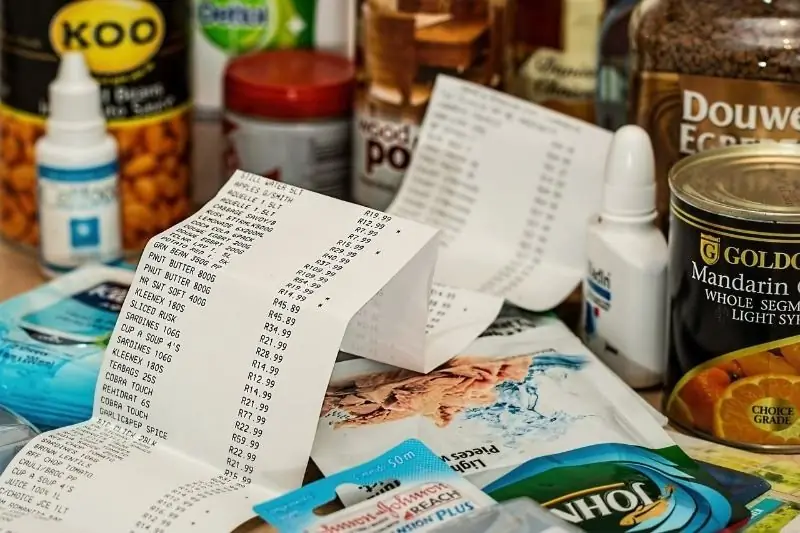
Table of contents:
- Author Bailey Albertson [email protected].
- Public 2023-12-17 12:53.
- Last modified 2025-01-23 12:41.
How to get rid of dampness, humidity and their unpleasant consequences in an apartment or house

Everyone dreams of a cozy and comfortable home. But even the most modern apartments are not immune to the appearance of mold due to too high levels of humidity in the premises. You can cope with the problem with the help of effective folk methods and industrial means.
Content
-
1 Causes of dampness
- 1.1 Where does mold appear
- 1.2 Why dampness may appear in the house - video
-
2 Instructions for reducing humidity in an apartment or private house
- 2.1 How to get rid of fungus in an apartment - video
- 2.2 Fungus under linoleum
- 2.3 Fungus under the wallpaper
-
2.4 Mold on plastic windows
2.4.1 How to get rid of condensation on PVC windows - video
-
2.5 Mold in the bathroom
2.5.1 What to do if black mold has formed in the bathroom - video
-
2.6 Mold in the basement
2.6.1 How to remove dampness from the cellar - video
- 3 Home remedies to combat fungus and indoor dampness
- 4 Preventing mold
Causes of dampness
The normal level of humidity in the apartment is no more than 60%. During a hot summer, this figure can be reduced to 45%. It is under such conditions that a person will feel as comfortable as possible. But if it is high, optimal conditions are created in residential premises for the development of dampness, and therefore, fungus.

High humidity in the room can cause fungus
The reason for the increased level of air humidity in residential premises can be:
- poor ventilation;
- damaged water pipes and improperly installed household plumbing;
- regular drying of linen in living quarters;
- frequent bathing;
- the presence of aquariums and a large number of indoor plants in the apartment;
- non-insulated inter-wall joints and cracks.
High humidity also forms during food preparation. To eliminate such a problem, it is often sufficient to ventilate the room well. But if the ceiling is leaking, getting rid of dampness will not be so easy.
The installation of plastic windows also contributes to the appearance of condensation in the room in summer and winter.

Condensation disrupts the normal microclimate in the apartment
Where does mold appear
Most often, mold can be found on walls and windows, ceilings and floors. Sometimes the fungus hides under carpets, in the pile, behind wallpaper, furniture and decorative objects on the walls, as well as in cabinets and bookshelves. If mold is found, immediate action must be taken to prevent the growth of the fungus and remove it completely.
Why dampness may appear in the house - video
Instructions for reducing humidity in an apartment or private house
-
One of the easiest ways to effectively deal with dampness in rooms is to regularly ventilate.

Airing the living space High-quality ventilation of the premises helps to remove excess moisture
-
Also, care must be taken to isolate sources of moisture. If the wall in the room becomes damp due to malfunctioning water or sewer pipes, it is necessary to take measures to eliminate the breakdown, which will allow the wall to dry out over time. But if dampness in a private house occurs due to the proximity of groundwater, the only way to solve the problem is to insulate the walls and foundation with waterproof materials, which can be purchased in specialized hardware stores. In some cases, it is advisable to organize additional heating of the room, which will allow you to dry damp corners and prevent further development of the fungus.

Room heating device Additional heating of the room will reduce humidity and dry out damp areas of walls and floors
-
To find out the reason why the walls of the dwelling are covered with moisture, you can use this method: attach a 50 cm long plastic sheet with tape to the inner surface of the wall, remove it after a few days and check the condition of the surface under it. If it is dry, mold is caused by high levels of humidity in the room. If wet, then the reason lies in water seeping through the wall. To get rid of this problem, you can use special water-repellent paints or plaster, which includes silicone or synthetic latex. To prevent dampness inside, these products are also applied to the outer walls. Moreover, in some cases, it is advisable to carry out complex repair work.

Paint buckets Water-repellent paints and plasters will protect walls from fungus
-
For private home owners, be aware that earthen floors are excellent moisture conductors. For this reason, it is advisable to cover them with polymeric materials or concreted.

Concrete floor leveling process Concrete floor does not allow excess moisture to pass through
-
Cracks must be removed with solutions that harden on contact with a wet environment. For the walls, use a plaster solution. When sealing defects located at the joints of walls and floors, epoxy materials are usually used.

The process of sealing cracks in the wall High-quality sealing of cracks will prevent the appearance of fungus in an apartment and a private house
-
Excessive humidity inside wooden buildings is caused by poorly caulked seams between logs and insufficient ventilation. You can cope with the problem using special antiseptic drugs and bleaches that effectively remove the fungus, for example, Bioshchit, Neomid, Remmers or Prosept.

The process of sealing the joints between the logs of a wooden building Sealing the seams between the logs and treating the wood with special compounds will prevent dampness inside the house
-
In apartments located in houses made of bricks, foam blocks and aerated concrete, with an increased level of humidity, it is advisable to use air dryers. These devices are ideal for killing excess moisture in bathrooms, toilets and kitchens.

Dehumidifiers Dehumidifiers can handle excess moisture in any living space
How to get rid of fungus in an apartment - video
Fungus under linoleum
Unwanted moisture often builds up under the linoleum. It is there that all the conditions for the development of mold are created, it is almost impossible to get rid of it and you have to change the coating. In this case, it is advisable to follow important recommendations:
- on floors affected by mold, in no case should old materials be laid;
- the fungus often spreads to the walls, therefore, the lower part of the wallpaper adjacent to the baseboards should be cut off;
- when installing a new linoleum, it is advisable to treat it with antifungal drugs.

To remove fungus under linoleum, you need to change the flooring
Fungus under the wallpaper
If mold has formed under the wallpaper, you must clean the surface from black spots using one of the solutions:
- from washing powder and chlorine (1-2 tablespoons of chlorine and 30-50 g of powder) - dilute the dry mixture with 3 liters of cool water, not forgetting to use protective equipment in the form of gloves and a respirator.
- from ½ bar of laundry soap, 100 g of soda and 5 liters of water.
Armed with a few clean rags and a sponge, the walls should be cleaned and dried using a household heater or infrared device. Then an antifungal agent such as Furacilin or Nystatin should be applied.
- Dissolve 4-6 tablets well in 0.5 liters of hot water.
- Add another 3-5 liters of water.
- Treat the walls of the room with a solution. Instead of these drugs, you can also use copper sulfate.
- Dry the surfaces thoroughly.
- Apply a primer for wallpapering. When choosing a suitable composition, you should pay attention to products containing antifungal substances.

The formation of fungus under wallpaper is a common problem in rooms with high levels of humidity.
Mold on plastic windows
If mold has formed on plastic windows and slopes, you should act immediately.
- Remove visible fungus stains using a 5: 1 bleach solution.
- Treat windows with ready-made antifungal compounds (Vincents, TEX, Polyline, Dufa) or made by yourself.
At home, you can make funds according to the following recipes:
- 0.2 liters of boric acid and 70% acetic acid per 1 liter of water;
- 100 g of sodium fluoride and copper sulfate per 1 liter of water;
- 100 ml of copper sulfate and household bleach per 1 liter of water.
The selected composition must be applied to the surface of plastic frames and slopes with a brush. To avoid the reappearance of mold, it is recommended to use rubber-based waterproofing mastics. With the help of such products, you can provide surfaces with a waterproof coating.
Do not forget about protective equipment - gloves and a mask. After finishing the treatment, ventilate the area for 40 minutes.

Plastic windows without ventilation systems often cause the appearance of mold and mildew
How to get rid of condensation on PVC windows - video
Mold in the bathroom
If mold appears in the bathroom, it is also necessary to treat the surfaces with antifungal compounds. If the fungus has formed on the ceiling, it should be removed along with the plaster by removing the sealant and paint from the affected areas. After the completion of the work, it is necessary to make sure that the pipes and mixers are not leaking, to eliminate the breakdowns. The joints of plastic parts can be treated with a sealant.

The cause of mold in the bathroom is the creation of conditions that are optimal for the life of harmful microorganisms
What to do if black mold forms in the bathroom - video
Mold in the basement
If mold has appeared in the basement, but the situation is not too bad yet, you can use the following method.
- Dissolve 250 ml of 40% formalin in 10 liters of water.
- Treat the affected areas of the walls with the composition and dry them.
- Then apply plaster to the walls and whitewash the ceiling. By providing the room with good ventilation, you will not have to worry about the reappearance of mold.

Basement mold is common in apartment buildings and private homes
How to remove dampness from a cellar - video
Home remedies for fungus and indoor dampness
In addition to industrial formulations, effective and inexpensive home-made products can be used to combat fungus.
- Take 0.5 kg of laundry soap, grate and dissolve in 5 liters of water.
- Boil the resulting composition, cool it.
- In warm summer weather, brush a few coats of soapy water on moldy walls without wallpaper.
- Then cover them with a composition made from 100 g of alum and 6 liters of water.
To cope with dampness, you can use calcium chloride, placing it in the corners. For reuse, it must be dried under the influence of high temperatures, and then ceiling. Charcoal and quicklime are suitable substitutes. However, when using this method, care should be taken that these substances are not available to children and pets.
Preventing mold
- To prevent mold growth, monitor the humidity level in the room with a hydrometer.
- Provide adequate ventilation and adequate sunlight.
- Use fans in the bathroom and in the kitchen, regularly check the draft in the ventilation shafts, monitor the condition of the plumbing units, especially at their joints.
- Repair cracks in walls and floors.
- When carrying out major renovations, use mineral-based materials to better regulate indoor humidity levels.
- Take care of high-quality waterproofing.
- Regularly inspect the plastic seals on PVC windows, check their suitability, carry out timely replacement.
- At the first appearance of condensation, promptly eliminate the cause of its formation.
Simple and affordable methods will help eliminate excess moisture in rooms, thereby preventing the development of harmful fungus. Using a variety of products and formulations, do not forget about safety measures that can protect your health. Taking preventive measures regularly will minimize the risk of mold reoccurring in your home.
Recommended:
How To Get Rid Of Spiders In A Private House, Apartment, Balcony, Windows And Other Places Forever, Tips With Photos And Videos

How to get rid of spiders in a house or apartment. Should you be afraid of them? How to remove spiders: effective chemicals and folk remedies
How To Get Rid Of The Smell Of Fish In An Apartment, On Various Surfaces, As Well As On Hands

Why does fish smell so bad? Describe and evaluate the effectiveness of proven ways to get rid of this odor from various surfaces. Video tips
How To Get Rid Of Rats In A Private House, Chicken Coop, Apartment And Other Premises - Using Various Methods To Get Rid Of Rodents

Reasons for the appearance of rats in the house. What methods, means to use in the fight against rats in various residential and non-residential premises. Preventive actions. Video
How To Eliminate The Smell Of Sewage In An Apartment Or A Private House, What To Do If It Smells Unpleasant In The Bathroom, Toilet Or Kitchen, The Causes Of The Problem

The causes of the smell of sewage in rooms. Ways to eliminate unpleasant odor, instructions with a photo. Video. Preventive measures
5 Things I Will Get Rid Of Before The New Year To Bring Happiness And Wealth Into The House, As Well As Get Rid Of Negativity

According to the old tradition, before the New Year, I get rid of 5 unnecessary things in order to let the positive energy of happiness and prosperity into my life
